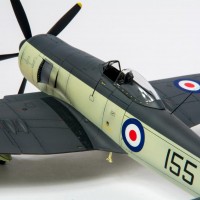Bronco's 1/48 RQ-1 Predator
Courtesy of the National Museum of the Air Force
Technically, the RQ-1 Predator is not just an aircraft but an entire system. Developed as an Advanced Concept Technology Demonstration (ACTD), this system consisted of four unmanned aerial vehicles (UAVs), a ground control station, a satellite communications terminal and 55 personnel. The Predator UAV in the museum -- the most recognizable part of the system -- provided military commanders with an Intelligence, Surveillance and Reconnaissance (ISR) platform capable of flying over dangerous areas for extended periods without risk to a human pilot.
In January 1994 the Department of Defense awarded a contract for ten Predator aircraft to General Atomics Aeronautical Systems of San Diego, Calif., and the first Predator flew just six months later in July 1994. Within a year, Predators deployed to Europe, where they proved their value in operations over Bosnia from July 1995 to March 1996. In April 1996, the Secretary of Defense selected the U.S. Air Force as the operating service for the RQ-1 Predator system, and the system entered production in August 1997. In subsequent deployments, the Predator continued to demonstrate its value to military leaders.
The pre-production version Predator aircraft was designated RQ-1K, but the entire system with all the components was designated the RQ-1A. Powered by a four-cylinder, 81-hp Rotax 912 engine, the RQ-1K aircraft could cruise at 87 miles per hour for 16 hours. The production version Predator aircraft was designated the RQ 1L, and it was equipped with a turbo-charged Rotax 914 engine producing 105 horsepower. The UAV on display is an RQ-1K.
In flight, the UAV and its on-board sensors are controlled by the ground crew with a direct data link. However, when the aircraft is flown beyond the range of a direct link, the ground crew maintains control though a satellite data link. The equipment carried in the bottom turret can provide live video, still photographs, or radar imagery in all weather conditions, day, or night. Using satellite data links, the information gathered by a Predator can be shared instantaneously with commanders around the world.
Designed and built to be easily deployed worldwide, the Predator systems operated from Creech Air Force Base, Nev. In February 2001 the Predator demonstrated a new potential. In a test program, it successfully fired a laser-guided Lockheed Martin AGM-114 Hellfire anti-tank missile at a stationary target.
This is a simple kit and the parts fit very well together making this an easy build, though the nose wheel is a bit fiddly. Perhaps the most difficult aspect is interpreting the instructions. For a detailed description of assembling, you can go to the Modeling Madness website https://modelingmadness.com/review/21st/sumrq1.htm









Excellent result and ditto article, John!
Thanks again
Superb result on this Predator, John @jsummerford
Well done.
Thanks. An armed option is in the kit, but I'm too lazy to paint and add missiles.
Nice and clean build and interesting story about the subject.
Thanks for sharing.
Thanks. I like taking advantage of previously published information.
Nicely accomplished, John
Thanks. This was one of the easier builds.
Excellent build of a historic drone.
Thanks